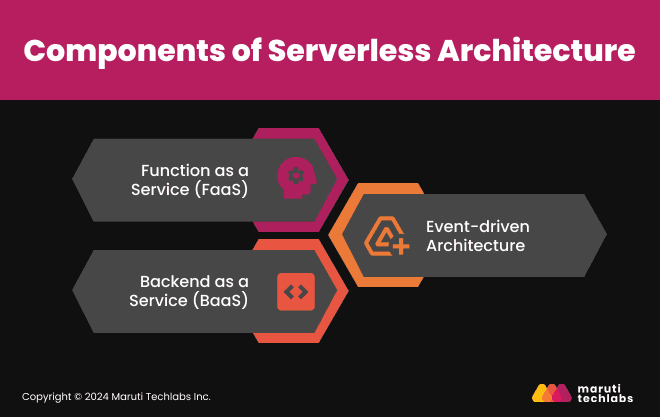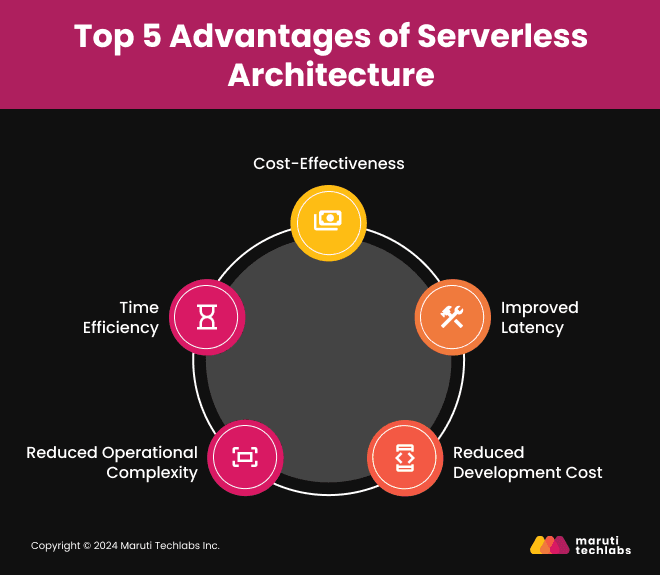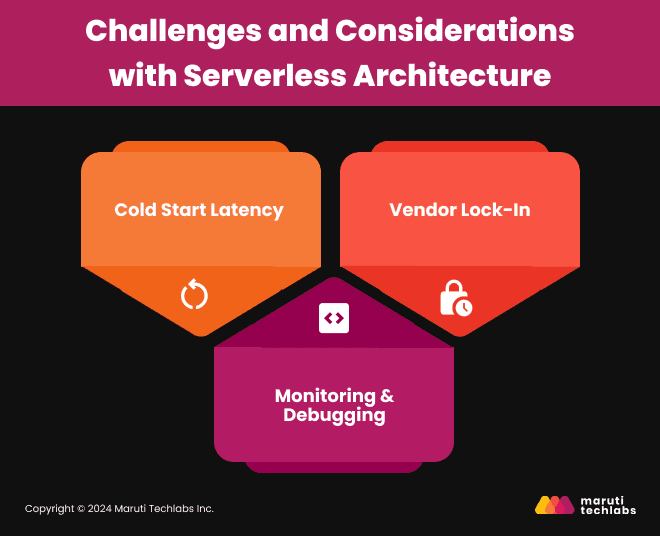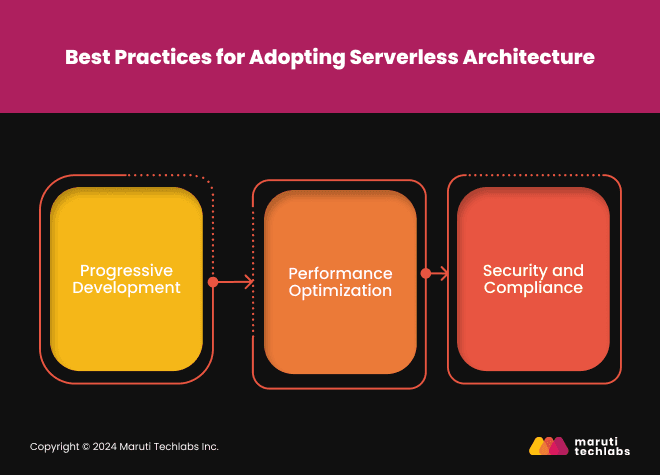

A Complete Guide to Serverless Architecture For Modern Apps






Serverless architecture enables the building of modern applications without the need to manage servers. Developers can focus more on writing code and creating features than dealing with infrastructure. According to Agileengine, companies can reduce their development effort by 36% after transitioning to serverless computing platforms.
With serverless architecture, you only pay for the computing power you use, which makes it very cost-effective. Shifting to serverless computing can reduce costs by 70-90% as it eliminates the need for hardware purchases, redundant services, or additional staffing.
This approach allows apps to scale automatically based on demand so they can handle more users without slowing down. Serverless architecture helps developers create better apps faster while saving money.
This guide explores the core components of serverless architecture, its advantages, limitations, and best practices. So, let's get started.
Serverless architecture for modern apps has key characteristics that benefit developers looking to build responsive and agile applications.

Here are the top 3 characteristics:
Serverless architecture automatically scales resources up or down based on demand. This flexibility ensures that applications can handle varying loads without manual intervention. Developers can now focus on building features rather than managing infrastructure.
In traditional setups, developers spend a lot of time managing servers and infrastructure. With serverless architecture, cloud providers take care of much of that work. Developers now focus on coding and building great features instead.
Serverless architecture is inherently event-driven. Its functions are triggered by specific events such as HTTP requests, database changes, or file uploads. This allows applications to respond instantly to user actions or system changes, improving responsiveness and efficiency.
Let’s explore the core components that make serverless architecture effective and efficient.
Several key components work together harmoniously to ensure seamless operation in serverless architecture for modern applications.

Let’s observe them briefly.
FaaS allows developers to create small, stateless functions that run only when needed. Providers like AWS Lambda manage these functions, so developers don’t worry about servers.
BaaS includes third-party services that handle tasks like user authentication, databases, and storage. It allows developers to add features without building everything from scratch.
Specific actions, called triggers, start functions automatically. For instance, when you use an API Gateway or make changes in the database, these triggers can activate specific functions.
Together, these components make serverless architecture for modern apps efficient and powerful, allowing developers to focus on creating great user experiences. Recognizing the core components, we can delve into the numerous advantages of serverless architecture to modern app development.
Serverless architecture for modern apps presents a range of compelling benefits that make it an attractive option for both developers and businesses. By leveraging this innovative approach, organizations can enhance efficiency and agility.

Here are the top 5 benefits:
One of the most significant financial benefits is the pay-per-use model. You only pay for the computing power you use, which can lead to substantial savings. It allows companies to allocate funds more efficiently.
Serverless architectures often utilize global access points, allowing applications to run closer to users regardless of their location. This geographic distribution minimizes latency, ensuring faster response times and a better user experience for customers worldwide.
With serverless architecture, developers can save money on infrastructure and focus on building features instead. This approach reduces the overall development cost, allowing teams to deliver products/services faster and more efficiently.
Managing servers can be complicated and time-consuming. Serverless architecture simplifies this by handling most operational tasks automatically. Developers can spend more time on coding and less on maintenance.
For instance, by adopting serverless architecture, Coca-Cola reduced operational costs by 65%.
Streamlining processes leads to better productivity. By eliminating server management, teams can launch new features quickly. For instance, a startup using serverless architecture can reduce its deployment time from weeks to hours, allowing it to respond rapidly to market changes.
Serverless architecture for modern apps provides businesses with cost savings, scalability, and efficiency. Now that we understand its advantages, let’s examine real-world use cases where it shines.
Serverless architecture for modern apps offers a wide array of innovative use cases that highlight its flexibility and effectiveness in addressing various business needs. Here are some notable use cases for modern applications:
Serverless architecture is popularly used in web applications. Developers can create dynamic content that changes based on user interactions. For instance, when you post a comment or like a photo, serverless functions can quickly process these events and update the content without slowing down the app.
Businesses looking for web development New York solutions can benefit greatly from serverless architecture. It allows for scalable, efficient, and cost-effective applications that deliver seamless user experiences without the complexities of server management.
Another great use case is in Internet of Things (IoT) applications. These apps often need to process real-time data from various devices.
For instance, smart home devices can send data to the cloud, where serverless architecture helps manage and analyze this information instantly. Users can control their devices efficiently and receive updates in real time.
Serverless architecture is also excellent for data processing and analytics. It can handle batch processing, where large amounts of data are processed at once, or stream processing, where data is analyzed as it comes in. Companies can use this to gain insights quickly and make better decisions based on real-time information.
Serverless architecture for modern apps provides flexible solutions across various industries, making it easier to build powerful applications.
While serverless architecture for modern apps offers many benefits, it also comes with some challenges that developers need to consider.
Though serverless architecture offers scalability and efficiency, it comes with its own challenges.

Some common challenges of serverless architecture are as follows:
CSL happens when a serverless function takes time to start up after being idle. To reduce this impact, developers can keep functions warm by scheduling regular calls or using tools that manage function performance. It ensures users experience faster response times.
Another concern is vendor lock-in. If you build your app using a specific cloud provider, it can take time to switch to another one later. To avoid this, developers can use open-source tools and design their applications to be more flexible. This way, they can move between different providers if needed.
Finally, monitoring and debugging can be tricky in serverless environments. Developers should use specialized tools to track performance and errors effectively. Best practices include setting up alerts for issues and logging important information to help identify problems quickly.
By acknowledging these challenges, we can better appreciate the best practices that ensure the successful adoption of serverless architecture for modern apps.
To make the most of serverless architecture for modern apps, it’s important to follow these best practices.

Start by designing your functions granularly. Break down tasks into smaller, manageable pieces. Each function should do one specific job. This process makes it easier to maintain and update your app.
Also, take advantage of managed services, which handle various tasks like databases and authentication. This way, you can focus on coding rather than managing everything.
To minimize cold start times, consider keeping your functions warm by scheduling regular calls. It helps apps start up faster. Additionally, ensure you use resources efficiently by monitoring usage and scaling appropriately. This will help your app run smoothly without wasting resources.
Ensure security by applying the principle of least privilege, granting users and functions only the permissions necessary to complete their tasks. You must also ensure data protection measures such as encryption and regular security audits.
Serverless architecture for modern apps is essential for building efficient and scalable applications. It allows developers to focus on coding by eliminating server management. Some key characteristics of serverless architecture include automatic scalability and cost-effectiveness.
The core components, including Function as a Service (FaaS) and Backend as a Service (BaaS), provide flexibility and ease of use. While there are challenges like cold start latency and vendor lock-in, following best practices like performance optimization can help mitigate these issues.
Maruti Techlabs offers expert serverless app development services that assist organizations in implementing serverless architecture effectively. Focusing on creating robust applications, Maruti Techlabs helps companies leverage this technology for better performance.
Get in Touch with us today and explore how serverless architecture can transform modern apps.
We also provide top-tier mobile app development services New York businesses rely on for scalable, modern solutions.
Serverless architecture is a cloud computing model for modern apps. It allows developers to build and run applications without managing servers. It enables automatic scaling and charges only for the computing power used, making it cost-effective and efficient.
Serverless architecture for modern apps automatically scales resources based on demand. As user traffic increases, the system adjusts without manual intervention, ensuring a smooth experience even during peak times.
The main benefits of serverless architecture for modern apps include cost savings through a pay-per-use model, reduced operational complexity, faster time to market, and the ability to focus on core development rather than infrastructure management.
While serverless architecture for modern apps suits many applications, it works best for event-driven and microservices-based designs. However, it may be better for applications with consistently high workloads.
Common challenges include cold start latency, vendor lock-in, and monitoring difficulties. Understanding these issues is crucial for effectively adopting serverless architecture for modern apps and ensuring optimal performance.


